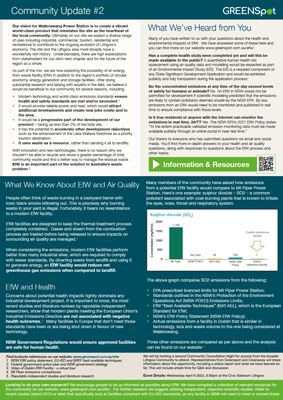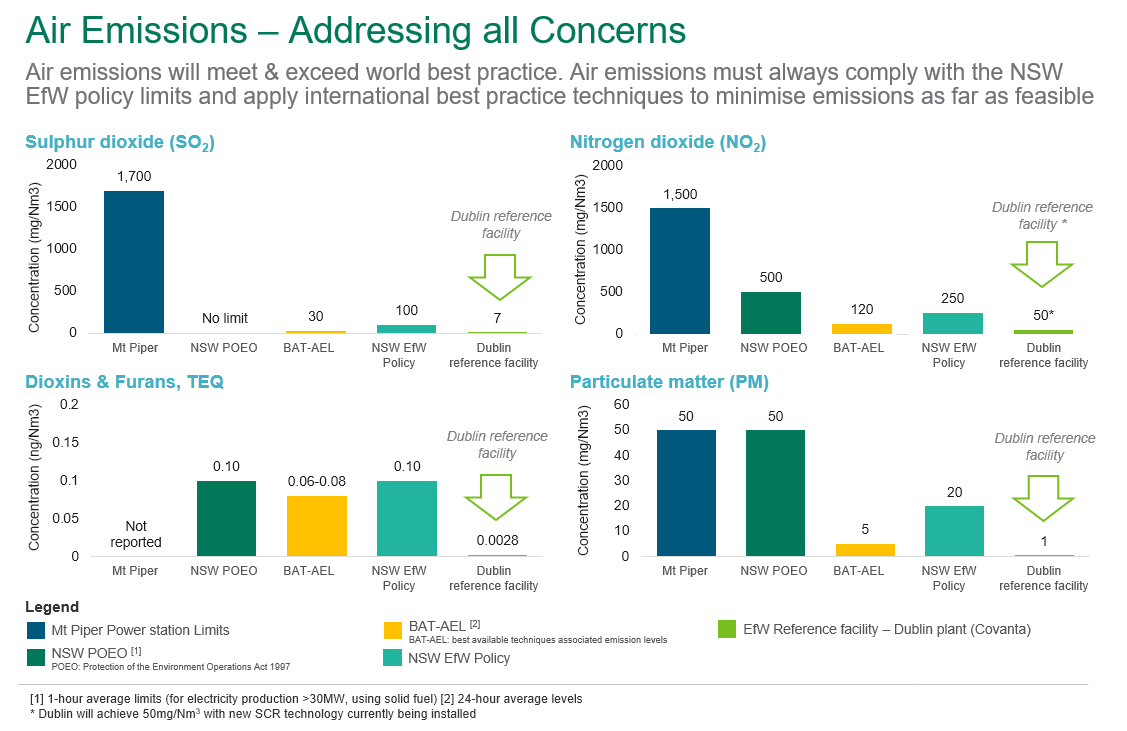EfW - More Resources
We want our community to be deeply informed about Waste Management and Recycling in general as well as Energy from Waste and as such we have compiled a collection of relevant resources we have been using to guide our consideration.
- International EfW Standards
- International Reference Facilities
- Australian Federal Waste Management Strategy, Policy and Reports
-
NSW Government Waste Management and EfW Strategy, Policy and Reports
- Waste and Sustainable Materials Strategy 2041
- Waste and Sustainable Materials Strategy FAQs
- EfW Infrastructure Plan
- EPA Draft Thermal Energy from Waste Regulation 2021
- Chief Scientist and Engineer Report on EfW
- Response to Chief Scientist and Engineer Report on EfW
- Energy From Waste Policy Statement
- Stakeholder Consultation Material
A sample of Community Questions and Answers
We'll continue to build this out as more questions come through so please visit this section regularly to keep up to date with community questions.
-
What happens to the waste before it is burnt - is the area going to become a big dumping ground?
After collection from homes or businesses, the residual (red bin) waste is taken to a facility for pre-sorting to remove hazardous waste and recyclables that have not been placed in the correct receptacle at the point of collection. After pre-sorting, the majority (approximately 80-90%) of waste would arrive at the facility by rail in sealed leak proof containers. These containers remain sealed during transit and are transported to the facility. To ensure that there is no offensive smell emitted from a facility, an EfW project would be contained within a large enclosure (like a shed) with automatic high-speed doors - where vehicles transit in and out. The EfW facility would also be designed to ensure negative air pressure (which essentially sucks the odour inside – and uses the air and odour particles in the combustion process).
An operating EfW facility would not become a big dumping ground. The received waste would be treated inside the facility with the combustion process undertaken within the facility itself. To understand how the storage and process is contained within a facility, you can take a virtual tour of a reference facility in Dublin here
-
What happens with the toxic ash residual left over after the rubbish is processed?
Following combustion, there are two types of ash produced: Incinerator Bottom Ash (IBA) and Flue Gas Treatment Residue (FGTr). IBA makes up around 15-20% of the original mass of waste (feedstock), which comprises of inert materials such as ash, glass and ceramics - plus ferrous and non-ferrous metals which can be removed from the IBA and recycled.
The FGTr makes up around 2-5% of the original mass of feedstock and is the fly ash and solidified pollutants captured in the flue gas treatment system. The FGTr has relatively high concentrations of heavy metals and needs to be safely disposed of at licenced landfill. For this reason, the FGTr is collected in sealed silos so that no ash escapes. It is then transported securely to a treatment facility where it is treated to immobilise pollutant molecules, before the ash is disposed of in a specially licensed landfill.
A useful visual reference for this can be found here
-
How much ash is leftover per week or per year?
At this stage there is no facility being formally proposed so volumes would depend on the size of a facility being proposed. However, we have based our research on a facility that would process up to 500,000 tonnes per year. This would result in ~375,000 – 412,500t of waste being diverted from landfill, ~75,000 - 100,000t of IBA which can be recycled and reused (with EPA approval) and ~12,500 – 25,000t of FGTr which would need to be disposed of in a suitably licensed landfill.
Averaged to a weekly basis this would equate to ~7,200-7,900t diverted, 1,400-1900t IBA and 240-480t FGTr respectively.
-
What emissions into our air are expected, and how does that compare to the emissions from Mt Piper?
The below graph compares Sulphur dioxide - SO2; Nitrogen dioxide – NO2, Dioxins and furans, TEQ and Particular Matter (PM) emissions with the following:
- EPA Prescribed licence limits for Mt Piper Power Station;
- Standards Outlined in the NSW’s Protection of the Environment Operations Act (NSW POEO) Emissions Limits;
- EfW “Best Available Techniques” (BAT-AEL), which is the European Standard for EfW;
- NSW EfW Policy Statement Emissions Limits (NSW EfW Policy);
- Actual emissions from a facility in Dublin that is similar in technology, size (capacity) and waste mixes and types to the one being considered at Wallerawang.
As you will see, in all cases here the Dublin reference facility (which is what would be considered at Wallerawang) is a tiny fraction of the EPA prescribed emission limit for Mt Piper and is well below the NSW EfW policy.
-
Has a complete health study been completed yet & will this be made available to the public also?
We expect that this, along with other issues, will be addressed in a comprehensive Environmental Impact Study (EIS) as part of a formal development application process. This would likely include a quantitative human health risk assessment in accordance with the ‘Environmental Health Risk Assessment: Guidelines for assessing human health risks from environmental hazards’ (enHealth, 2012) covering the inhalation of criteria pollutants and exposure (from all pathways, i.e. inhalation, ingestion and dermal) to specific air toxics, including impacts from the transport of waste material and consideration of the impacts on drinking water sources such as reservoirs and rainwater tanks, including the impacts on water quality and human health. The EIS would be exhibited publicly during the application process, as well as reviewed by various Government and Regulatory bodies – plus a team of Independent (Government) appointed specialists in Human Health.
-
Will a full environmental effects study be carried out prior and will it be available to all of us? If so, who will be carrying out the study?
A Comprehensive Environmental Impact Study (EIS) is a requirement of the formal development application process. The EIS is put on public exhibition during the application process where anyone can make a submission and comment on the proposal.
-
Do the concentrated emissions at any time of the day exceed levels of safety for humans or animals? Is Sydney Water having a say on what the emissions are allowed seeing that anything from the facility has a chance to pollute Lake Wallace and poison water consumers downstream, especially Sydney residents?
An Energy from Waste (EfW) facility in NSW would not be permitted for development if scientific modelling predicted that the emissions are likely to contain pollutants that exceed levels deemed safe by the NSW Environment Protection Authority. Emissions from an EfW facility would need to be monitored constantly to ensure compliance with those levels. This would be contained within an Operating Licence issued, and monitored by the NSW EPA which must be complied with during operation of a facility.
As part of a formal development application for an EfW facility all relevant authorities are consulted on any potential impacts arising from the development. Each authority also has the ability to request that any proposal should consider specific factors – which would include water bodies and other natural features. A key stakeholder for the site is likely to be Water NSW - amongst others in the consultation process.
Information presented to them is likely to include a quantitative human health risk assessment in accordance with the ‘Environmental Health Risk Assessment: Guidelines for assessing human health risks from environmental hazards’ (enHealth, 2012) covering the inhalation of criteria pollutants and exposure (from all pathways, i.e. inhalation, ingestion and dermal) to specific air toxics, including impacts from the transport of waste material and consideration of the impacts on drinking water sources such as reservoirs and rainwater tanks, including the impacts on water quality and human health.
-
Is it true residents or anyone with the internet can monitor the emissions, realtime, 24/7?
Yes. As part of the NSW EPA’s EfW Policy which was published in 2021, the policy states:
"Emissions reporting: To the extent practicable validated emission monitoring data must be made available publicly through an online portal in near real time. Emission monitoring data must be made available to the EPA in real time graphical publication and a weekly summary of continuous monitoring data and compliance with emissions limits published on the internet."
-
How much monitoring will the EPA carry out, as in constant ongoing monitoring to make sure emission levels never exceed what they are supposed to, or just a regular weekly or monthly review?
If a facility was to be approved, the Environment Protection Authority (EPA) issues environment protection licences to the owners or operators of various industrial premises under the Protection of the Environment Operations Act 1997 (POEO Act). Licence conditions relate to pollution prevention and monitoring, and cleaner production through recycling and reuse and the implementation of best practice.
The EPA review and monitor compliance to all licences, however in addition to this, it is the Operators responsibility to undertake, and publish online (in real time) accurate constant monitoring of emissions from the facility. The EPA through government legislation would enforce compliance with that responsibility.
As part of the NSW EPA’s EfW Policy which was published in 2021, the policy states: “Emissions reporting: To the extent practicable validated emission monitoring data must be made available publicly through an online portal in near real time. Emission monitoring data must be made available to the EPA in real time graphical publication and a weekly summary of continuous monitoring data and compliance with emissions limits published on the internet.”
-
How many will be needed to build the facility, how long to build it, and how many permanent staff to run it? If it is approved.
An Energy from Waste (EfW) facility capable of processing 500,000t per year with associated rail infrastructure would employ approximately 1,000 direct jobs and 1,250 direct jobs during a 3-year construction period and 85 full time staff during operation.
-
Was this same proposal rejected when submitted for Eastern Creek or close to Sydney? If so what basis was it rejected? If approved for Sydney why didn't it go ahead?
No. The Next Generation (NSW) Pty Ltd was the applicant for the energy from waste facility in Eastern Creek that was refused by the Independent Planning Commission.
The NSW Governments Energy-from-Waste Infrastructure Plan which was released in September 2021 limits the development of Energy-from-Waste facilities to four Priority Infrastructure Areas, all of which are located outside the Sydney Basin. West Lithgow is one of those priority areas which is why we are considering the opportunity this presents to the Lithgow region.
Other links relating to this can be found here:
-
Has Sydney Water lodged an objection to the proposal?
No. Agency objections are submitted when a development application and accompanying Environmental Impact Study (EIS) for a proposed EfW facility is submitted to the Department of Planning Industry and Environment (DPIE) who refer it to a number of agencies for advice. There is currently no formal proposal lodged for the Wallerawang site.
For any further information or questions please email us at communityinfo@greenspot.com.au


